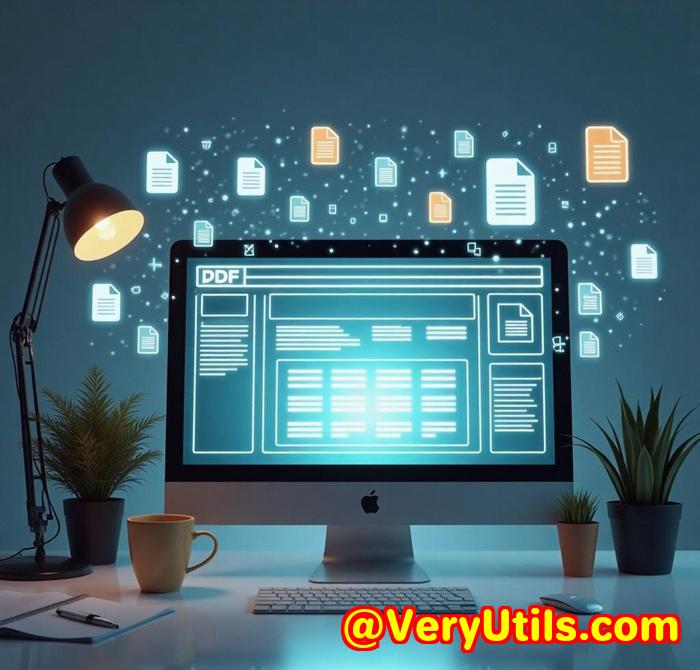Title
Preserve Layout and Fonts When Converting Legacy PCL to PDF with VeryPDF Command Line
Meta Description
Convert legacy PCL files to high-fidelity PDFs without losing design or fonts using VeryPDF's powerful command-line tool.

Every IT migration project has that one legacy format that just won't go quietly. For us, it was an archive of PCL filesthousands of themgenerated by an old print system we decommissioned last year. These weren't just any files. They were invoices, reports, and operational documents going back over a decade. The content was crucial, but even more critical was the formatting. The layout, fonts, and embedded elements had to remain intact. But how do you preserve exact visual fidelity when moving from an outdated PCL format to modern PDFs? That's where the VeryPDF PCL to PDF Converter Command Line became our unexpected hero.
Why I Turned to VeryPDF for PCL to PDF Conversion
Initially, we tried a few free converters and print-to-PDF drivers, but every single one either butchered the layout or failed to process batch jobs. I started researching professional tools and stumbled upon VeryPDF PCL to PDF Converter Command Line. The command line interface, robust format support (PCL, PX3, PXL), and reputation for precision drew me in.
This tool is built for professionalsIT admins, developers, document management teams, and system integratorswho need total control over PCL conversion without compromising on accuracy. It's ideal for migrating document systems, automating workflows, or integrating legacy formats into modern environments.
Core Features That Made a Real Difference
1. Accurate Layout and Font Retention
One of the biggest risks with PCL conversion is layout distortion. Fonts go missing, spacing shifts, or entire pages break. VeryPDF handled this beautifully. It supports font embedding and font mapping via mapfont.ini, ensuring the output PDF looks identical to the original printed file. I used the -embedfonts yes and -mapfont options to preserve a custom monospaced typeface that's critical for our documents.
2. Batch Conversion with Wildcard and Directory Support
We had over 20,000 files across nested directories. Manually processing these was not an option. VeryPDF's support for wildcard characters and recursive directory operations was a lifesaver. I simply ran:
It even sorted files by name automatically during batch conversionno extra scripting needed.
3. Metadata, Encryption, and PDF Merge Functions
Another pleasant surprise was how much control the tool gave us over output customization. We added metadata (title, author, subject) and set permissions like "no modification" or "no printing" using the -encryption and -keylen flags. It also merged multiple reports into a single indexed PDF using -mergepdf, which we then archived for search indexing.
What Sets VeryPDF Apart
I tried a few GUI-based tools before this, but they struggled with large volumes or lacked support for exact PCL rendering. VeryPDF's command line interface may not look flashy, but it's built for speed and reliability. It even supports integration via scripting languages like C#, PHP, and ASP.NETwhich we'll be leveraging in phase two of our automation project.
Also worth noting: the conversion speed is excellent. We processed all 20,000 files in under 30 minutes on a mid-range server. And the output? Perfectly preserved fonts, page layouts, and color fidelity.
My Verdict and Recommendation
Migrating legacy document formats can feel like walking through a minefield of broken formatting and lost data. VeryPDF PCL to PDF Converter Command Line made that process smooth anddare I sayenjoyable. It saved us dozens of hours, preserved our document integrity, and integrated flawlessly with our scripts and systems.
I'd highly recommend this tool to any IT professional, document manager, or developer dealing with legacy PCL files. Whether you're modernizing archives or automating print systems, this is the tool you want in your kit.
Click here to try it out for yourself
Custom Development Services by VeryPDF
If you need something more tailoredlike automated server-based PDF processing, virtual printer driver development, or API-level integrationVeryPDF has you covered. Their team provides custom development services across Windows, Linux, macOS, Android, and iOS platforms.
They can create solutions involving:
-
Windows printer job interception and conversion to PDF/EMF/PCL/Postscript
-
OCR and layout analysis
-
Barcode generation/recognition
-
PDF security, DRM, and digital signatures
-
TrueType font mapping and embedding
-
API-level monitoring, document indexing, and cloud-based document workflows
Have a custom project in mind? Contact their support team to discuss your requirements.
Frequently Asked Questions (FAQ)
Q1: Does VeryPDF PCL to PDF Converter support batch conversion?
Yes, it supports batch processing using wildcards and directory-level commands, making it ideal for handling thousands of files.
Q2: Can I preserve fonts and formatting during conversion?
Absolutely. Use -embedfonts and -mapfont options to retain original layout and font fidelity.
Q3: Can I integrate this tool with other software systems?
Yes. With a server or developer license, you can call the tool from C#, PHP, ASP.NET, and other languages.
Q4: Is Adobe Acrobat required?
No. This is a standalone tool. You don't need Acrobat Reader or any third-party PDF software to use it.
Q5: Can I add encryption and permissions to the output PDFs?
Yes, you can set owner/user passwords, apply 40- or 128-bit encryption, and restrict printing or editing.
Tags or Keywords
-
PCL to PDF conversion
-
Preserve PCL layout
-
Batch convert PCL files
-
Legacy document migration
-
VeryPDF command line tools